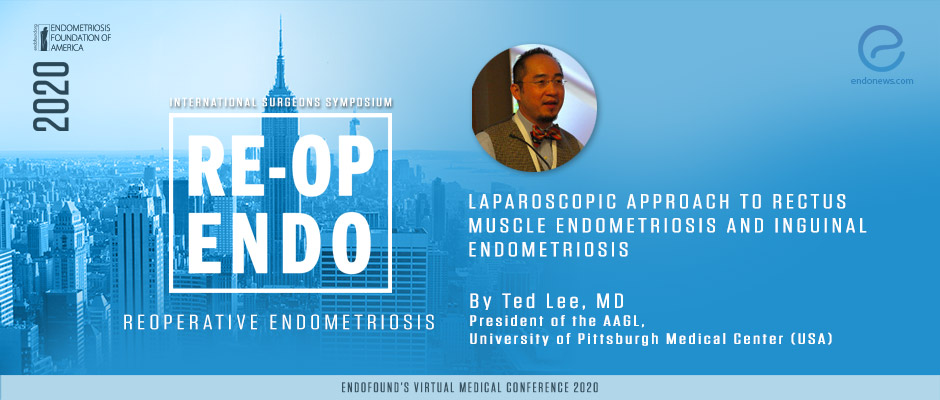Laparoscopic Approach to Rectus Muscle Endometriosis and Inguinal Endometriosis - Ted Lee, MD
Jan 8, 2021
For the removal of these two rare types of endometriosis, detailed laparoscopic techniques are shown in operating room videos.
Key Points
Information for the presentation: Ted Lee MD., is the director of Minimally Invasive Gynecologic Surgery in the Medical Center of the University of Pittsburgh, at Magee Women's Hospital, USA, and vice-president of AAGL. His presentation is about the " Laparoscopic approach to Rectus muscle endometriosis and Inguinal endometriosis" during Endofound 2020 meeting.
Importance:
- Almost all patients with rectus muscle endometriosis have a history of a Cesarean section. The unlikely palpable mass on the subfacial rectus muscle is responsible for frequent misdiagnosing of this disease.
- Inguinal endometriosis is another rare condition that usually results in the complaints of patients to take them to general surgery.
Highlights:
- To remove endometriotic nodules from the inguinal canal should be performed by a skilled laparoscopic surgeon and needs a careful approach as several major vessels within this area are important.
Remarks:
- For a definite diagnosis of rectus muscle endometriosis and inguinal endometriosis, MRI is mandatory. Only for small lesions inside the rectus muscle, an ultrasonographic approach with a needle is achievable. Determining the proximity of inguinal endometriosis to major vessels is very important.
- Bladder endometriosis is not uncommon with rectus muscle endometriosis and it may occur by the spread. With inguinal endometriosis, there is almost always deep endometriosis somewhere in the pelvis in contrary to rectus muscle endometriosis.
- Removal of the rectus muscle endometriotic nodules should be achieved by squeezing technic and complete resection of the lesion. If the fascial defect is too big, a mesh could be placed in this area.
- Most of the cases with inguinal endometriosis present to general surgeons instead of gynecologists due to its location. The operation could be dangerous due to neighboring big vessels into and close to the inguinal canal, whereas general and vascular surgeon consultations are essential before planning it.
- Dr. Lee recommends using a 45-degree angle scope to visualize both the rectus muscle endometriotic nodules and the inguinal canal endometriosis.
Lay Summary
Rectus muscle endometriosis and inguinal endometriosis are two rare types of endometriosis. Operation room videos of several patients with different rectus muscle endometriosis and inguinal endometriosis are shared during the presentation of Dr. Lee to clarify the methods of the laparoscopic approach to these diseases.
More than seventeen percent of abdominal wall endometriosis involves rectus muscles. The main symptom is cyclic abdominal pain with or without palpable mass on rectus muscles and this pain is worsening with activities that engage the abdominal wall like sitting down or coughing. MRI allows for better assessment of the layers of the abdominal wall and allows to decide whether a major abdominal wall reconstruction is needed. Smaller lesions could be visualized and operated by needle localization with ultrasound.
While preparing for the operation a needle is inserted in the rectus muscle by ultrasonographic guide to show the localization of the nodule. In terms of setting up for rectus muscle endometriosis, Dr.Lee recommends a 45-degree angle scope or a flexible laparoscope.
The insertion of trocars depends on the localization of the endometriosis on the rectus muscle. Usually, the nodule is below ASIS (anterior superior iliac spine), so after replacing the umbilical trocar as a camera port, the surgeon could operate from any of the three lower ports according to the place of the nodule. Collection of the nodules are made by squeezing the abdominal wall to facilitate the enucleation of the lesion. When the rectus muscle endometriosis localized above ASIS, the supraumbilical port will be the camera port. In this situation, the operation will go on mainly from the umbilical port.
If the nodules of rectus muscle endometriosis are very big and after removal of them a large defect of the fascia occurs, a mesh replacement indication arises. After replacing the mesh to the defective side and stitch it to the borders of the fascial lesion, a flap of omentum shield used to fix it. This technic will prevent the adhesions between bowels and the mesh.
The location of inguinal endometriosis ranges from the entrance of the round ligament to deep into the inguinal canal above the femoral artery and could be accompanied by deep endometriosis elsewhere in the pelvis.
Besides other neighboring vessels and nerves, the inferior epigastric artery could be much commonly involved with the inguinal endometriotic nodule and make the approach dangerous during the excision.
Research Source: https://www.endofound.org/laparoscopic-approach-to-rectus-muscle-endometriosis-and-inguinal-endometriosis-ted-lee-md?pop=mc
laparoscopy rectus muscle endometriosis inguinal endometriosis inferior epigastric artery. mc2020

